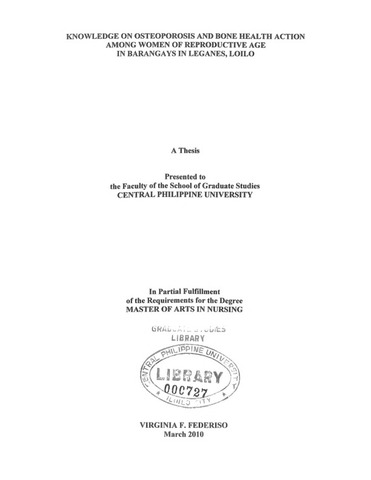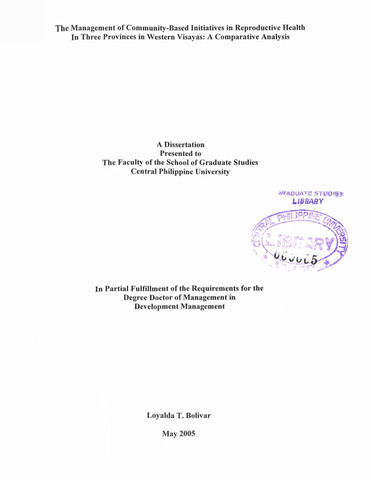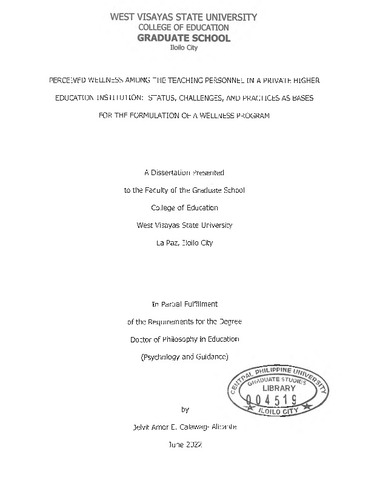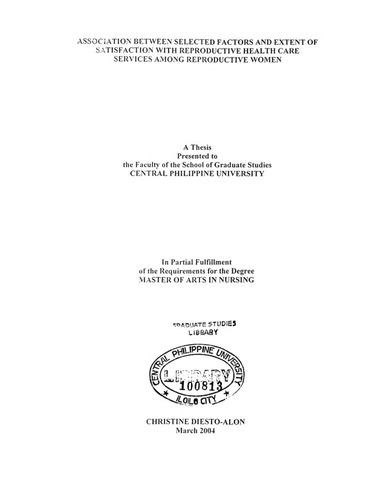| dc.description.abstract | This study was conducted to determine the level of knowledge on osteoporosis and bone health action among Women of Reproductive Age (WRA) in barangays in Leganes, Iloilo. It aimed to determine whether knowledge on osteoporosis and bone health action vary according to demographic/personal characteristics of the respondents such as age, civil status, educational attainment, type of occupation, income, family history of osteoporosis and fracture. Sources of information about osteoporosis were also ascertained. Furthermore, the study determined whether there is a relationship between knowledge on osteoporosis and bone health action.
The respondents of this study were 201 WRA in four barangays in Leganes, Iloilo, namely, Bigke, Camangay, M.V.Hechanova and Napnud who were randomly selected through stratified sampling, and finally by systematic random sampling.
This study is descriptive correlational utilizing one-shot survey design. Data were gathered using a researcher-made interview schedule which was subjected to face and content validation, translated to Hiligaynon and tested for reliability with 10 Women of Reproductive Age in Guintas, Leganes, Iloilo. The data were processed using the Statistical Package for the Social Sciences (SPSS) software 12.0 for Windows.
Major Findings of the Study
1. The results of the study revealed that the Women of Reproductive Age, on the average, were younger (15-30 years old), the average age was 30 years old; majority were married/separated/widowed, with high school education, without paid work, with family monthly income of PhP7,000.00 and below, and with no family history of osteoporosis and fracture.
2. The level of knowledge on osteoporosis of the WRA was high. They had very adequate knowledge on osteoporosis, its nature, risks, signs and symptoms, bone health promotion, prevention of osteoporosis, its treatment and management.
3. The women with high knowledge on osteoporosis include those who were 15-30 years old, single, college/graduate level education, with or without paid work, with monthly family income of PhP7,000.00 and below, those with family history of osteoporosis, and those with no family history of fracture.
4. The WRA’s top three sources of information about osteoporosis were the broadcast (television/radio) health professionals (doctors, nurses, midwives) and barangay health workers (BHWs). Other sources of information which gave information to the women were the print material (newspapers, magazines, pamphlets) and the internet.
5. No significant difference existed in the level of knowledge on osteoporosis among WRA when classified according to age, civil status, educational attainment, employment status, income, family history of osteoporosis and fracture.
6. The level of bone health action among the women was good. The activities they did indicate good level of bone health. The women who obtained the highest mean score in bone health action were the younger WRA (15-30 years old), married/separated/widowed, with secondary level of education, with paid work, with family monthly income of PhP7, 000.00 and above, with family history of osteoporosis, and those with no family history of fracture.
7. No significant difference existed in the level of bone health action among WRA when they were classified according to age, civil status, educational attainment, employment status, family history of osteoporosis and fracture.
8. No significant relationship existed between level of knowledge on osteoporosis and level of bone health action among the WRA in barangays in Leganes, Iloilo. Knowledge on osteoporosis and bone health action was independent of each other.
Conclusions
1. The WRA in barangays in Leganes, Iloilo have very adequate knowledge about osteoporosis, its nature, risks, signs and symptoms, bone health promotion, prevention of osteoporosis, its treatment and management.
2. The top three sources of information that the women had utilized and gave them information about osteoporosis were the broadcast media, health professionals and barangay health workers.
3. Knowledge about osteoporosis among WRA was high regardless of their personal characteristics.
4. The WRA of Barangays in Leganes, Iloilo have good bone health actions which are very supportive of good level of bone health. They were taking measures to prevent osteoporosis by eating calcium-rich foods such as milk, fish, poultry and meat products, eating foods rich in vitamins C and D, and green leafy vegetables; avoiding bone hazards such as drinking of tea, alcoholic and cola drinks and smoking; exposure to sunlight, performance of weight-bearing exercises, proper posture, and maintaining the surroundings to prevent falls and injuries; though only a few had taken calcium supplements, vitamin C and D tablets and sought medical consultation for bone health.
5. Bone health action among WRA was good regardless of their personal characteristics.
6. Knowledge about osteoporosis and bone health action of WRA is independent of each other.
7. WRA are concerned with their bone health, thus they made themselves well informed about osteoporosis, its nature, risks, bone health promotion and osteoporosis prevention, and practiced some measures to maintain bone health. Empowerment of women may have brought an increasing consciousness about osteoporosis and the need for bone health action against this silent disease. Education and sources of information about osteoporosis also played great roles as influencing factors in making WRA more knowledgeable about osteoporosis. Women could have accumulated more learning which had widened their knowledge base through education and sources of information about osteoporosis.
8. Regardless of their demographic characteristics, WRA were concerned oftheir bone health. This indicates that health is an individual responsibility.
9. The findings substantiate Pender's Health Promotion Model. Women valued growth in directions viewed as positive and attempted to achieve a personally acceptable behavior. These women might have actively regulated their behavior in seeking knowledge about osteoporosis and practice bone health promotion. Findings revealed there was no relationship between knowledge on osteoporosis and bone health action. Knowledge on osteoporosis did not differ according to age, civil status, educational attainment, type of occupation, family history of osteoporosis and fracture. However, knowledge differed according to income, in favor of those whose family income was less.
10. Bone health action did not differ according to WRA’s demographic characteristics.
11. Knowledge on osteoporosis was high, and bone health action was good. Interpersonal influence provided by family members, friends and health providers may have contributed to women's knowledge on osteoporosis and influenced their decision to take preventive measures against osteoporosis.
12. The results of this study have shown data about the level of knowledge on osteoporosis and bone health action among WRA in four barangays in Leganes, Iloilo
Recommendations Based on the aforementioned findings and conclusions, the following recommendations are advanced:
1. The WRA of barangays in Leganes, Iloilo have high level of knowledge on osteoporosis and good bone health action, but they are encouraged to learn more about the disease, bone health promotion and prevention of it through reading, attending seminars and health education classes.
2. Doctors, nurses, midwives and BHWs are encouraged to continue disseminating information about osteoporosis, considering that health professionals and BHWs were respectively the second and third sources of information chosen by WRA that gave them information about osteoporosis.
3. WRA’s knowledge about osteoporosis and bone health action should be enhanced some more through lectures, seminars, and other forms of information dissemination like preparation of correct Information, Education and Communication campaign materials (IEC materials) such as leaflets or pamphlets. This pose a challenge to the members of the academe, the nurse-educators and nursing students who are working with the co-partners in health and development in the grassroots levels. Bone health promotion and osteoporosis prevention should be given emphasis when conducting health education classes in any health care setting.
4. People involved in making Information. Education and Communication materials, and those who discuss about osteoporosis and bone health should preferably be experts in joint and bone health to ensure correct information is given to the people. If ever that a layman will discuss about osteoporosis in any setting, such as in television, radio and in a learning hall, what arc discussed should have been screened and edited by an expert in joint and bone health.
5. Nurses and other health team members must promote family-centered/focused care in the delivery of primary, secondary, and tertiary prevention to promote bone health. All family members, not only WRA should understand what bone health promotion is, what osteoporosis is, its prevention and management. The family has to work as a unit.
6. The Barangay Councils, the Local Government Unit (LGU), and the Department of Health should collaborate to assess and plan to meet the health care needs of WRA.
7. Barangay consultations should be done by the Local Government Unit so as to determine the needs of WRA.
8. WRA should empower themselves more to gain more knowledge about osteoporosis, and to maintain or much as possible increase their bone health actions such as in performing weight-bearing exercises, exposure of 15 minutes in a day to gentle sunlight in the morning, eating calcium, vit C and D-rich foods, proteins, avoidance of bone hazards, and more.
9. Women should also assess and evaluate if the sources of information they are utilizing could be trusted. They need to screen information they obtain from different sources in order that they have the right knowledge about the disease. They can also consult a doctor and discuss about the osteoporosis and other bone-related diseases, their nature, risks, signs and symptoms, bone health promotion, prevention of bone-related diseases, their treatment and management.
10. WRA should be encouraged to share what they know about osteoporosis and what they practice to protect themselves against this disease, especially to the younger generation before they reach their peak bone mass.
11. This study may be replicated and conducted in other places with wider coverage and involving more variables. | en_US |





